Magmatic Intrusion during the Yanshanian Period and Multi-Mineral Enrichment Mechanisms in the Eastern Margin of the North China Craton
Abstract
:1. Introduction
2. Geological Background
2.1. Tectonic Setting
2.2. Characteristics and Spatial Distribution of Magmatic Intrusions
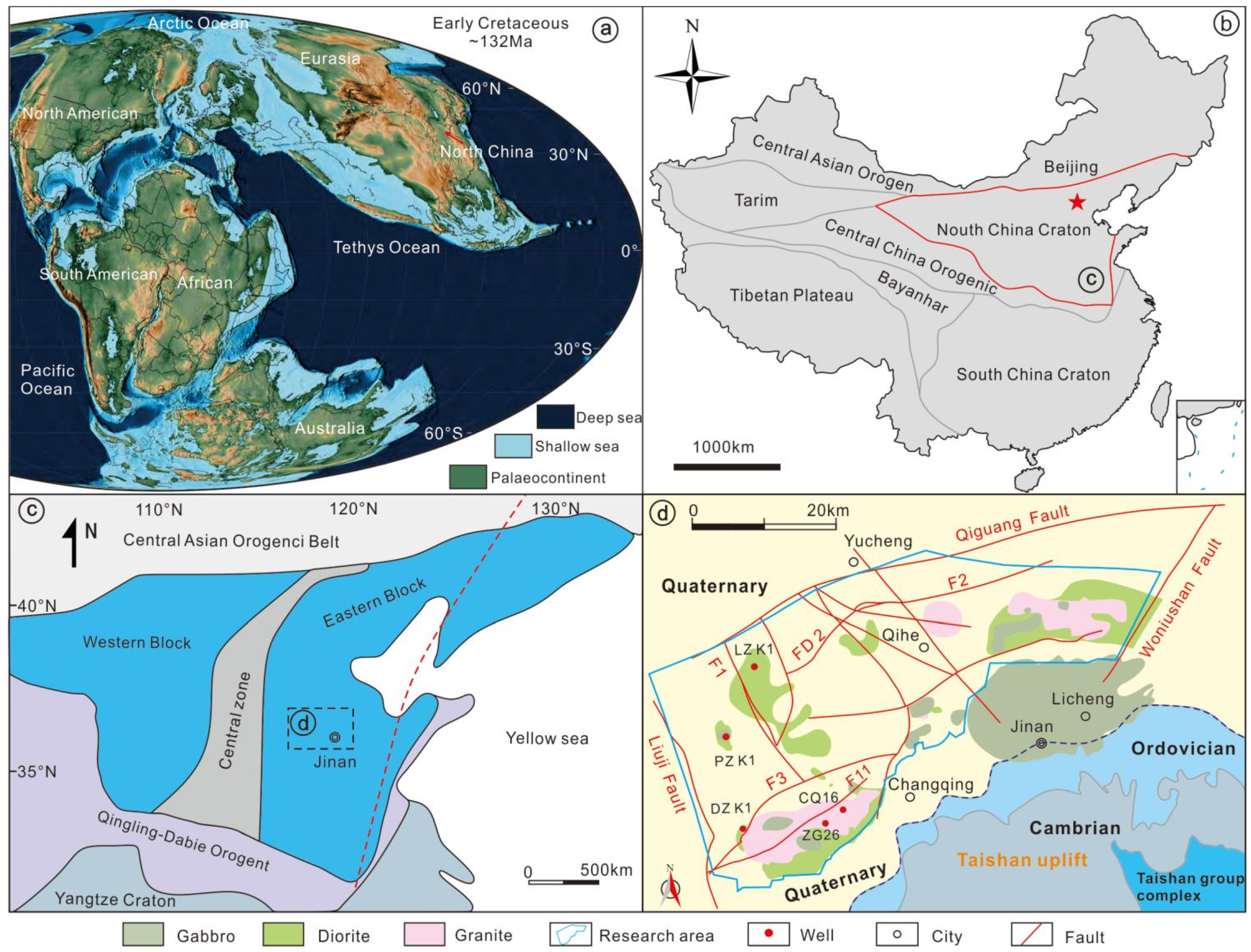
2.3. Characteristics and Spatial Distribution of Skarn-Type Iron Ores
3. Thermal Evolution and Gas Enrichment Mechanism of Source Rocks
3.1. Metamorphism of Coal Seam and Enrichment Mechanism CBM
3.2. Shale Thermal Evolution Degree and Shale Gas Enrichment Mechanism
4. Mineralization Regularity of Skarn-Type Iron Ore
5. The Relationship between NCC Destruction and the Mineralization of Skarn-Type Iron Ore, CBM, and Shale Gas
6. Conclusions
- Various stages of magmatic intrusion during the Yanshanian period significantly influenced the Late Paleozoic coal measures in the HHBC. The coal measures exhibit distinct ranks, ranging from medium-rank bituminous C to A and high-rank anthracite C, resulting in noticeable differences in gas generation among different coal ranks. The shale between the coal seams C5 and C7 emerges as excellent, with a good hydrocarbon-generating capacity during the middle-maturity stage.
- The “Intrusion along the rock layer type” proves most conducive to shale gas enrichment, while the “laccolith type” is more favorable for shale gas enrichment compared to “dike type” intrusions, which have a limited impact on shale gas enrichment.
- The mineralization process of CBM, shale gas, and iron ore is influenced by Yanshanian-period magma. The enrichment degree of CBM and shale gas exhibits an inverse correlation with the distance from the magmatic intrusion. Iron deposits demonstrate a close association with the magmatic intrusion, with enhanced enrichment along the rock layer.
Author Contributions
Funding
Data Availability Statement
Acknowledgments
Conflicts of Interest
References
- Zhai, M.G. Tectonic evolution of the North China Craton. J. Geomech. 2019, 25, 722–745. [Google Scholar]
- Zhu, R.X.; Yang, J.H.; Wu, F.Y. Timing of destruction of the North China Craton. Lithos 2012, 149, 51–60. [Google Scholar] [CrossRef]
- Li, S.Z.; Suo, Y.H.; Li, X.Y.; Zh, J.; Santosh, M.; Wang, P.C.; Wang, G.Z.; Guo, L.L.; Yu, S.Y.; Lan, H.Y.; et al. Mesozoic tectono-magmatic response in the East Asian ocean-continent connection zone to subduction of the Paleo-Pacific Plate. Earth-Sci. Rev. 2019, 192, 91–137. [Google Scholar] [CrossRef]
- Zhu, R.X.; Xu, Y.G.; Zhu, G.; Zhang, H.F.; Xia, Q.K.; Zheng, T.Y. Destruction of the North China Craton. Sci. China Earth Sci. 2012, 55, 1565–1587. (In Chinese) [Google Scholar] [CrossRef]
- Dong, Y.P.; Sun, S.S.; Santosh, M.; Zhao, J.; Sun, J.P.; He, D.F.; Shi, X.; Hui, B.; Cheng, C.; Zhang, G.W. Central China Orogenic Belt and amalgamation of East Asian continents. Gondwana Res. 2021, 100, 131–194. [Google Scholar]
- Mao, J.W.; Pirajno, F.; Xiang, J.F.; Gao, J.J.; Ye, H.S.; Li, Y.F.; Guo, B.J. Mesozoic molybdenum deposits in the east Qinling-Dabie orogenic belt: Characteristics and tectonic settings. Ore Geol. Rev. 2011, 43, 264–293. [Google Scholar] [CrossRef]
- Wang, H.H.; Shen, L.J.; Wang, D.D.; Zhu, Y.Z.; Li, Z.X.; Wang, Y.J.; Mao, Q. Study on Mesozoic magmatic intrusion and Paleozoic multi-mineral genesis mechanism in Huanghebei Coalfield, Shandong Province. Coal Geol. Explor. 2021, 49, 83–92. (In Chinese) [Google Scholar]
- Einaudi, M.T. Skarn Deposits; Economic Geology Publishing Company: Littleton, CO, USA, 1981; Volume 75, pp. 317–391. [Google Scholar]
- Meinert, L.D. Mineralogy and petrology of iron skarns in western British Columbia, Canada. Econ. Geol. 1984, 79, 869–882. [Google Scholar] [CrossRef]
- Meinert, L.D.; Dipple, G.M.; Nicolescu, S. World skarn deposits. Econ. Geol. 100th Anniv. 2005, 299–336. [Google Scholar] [CrossRef]
- Wang, D.D.; Zhang, G.C.; Li, Z.X.; Dong, G.Q.; Sun, R.; Guo, S.; Wu, Y. The Development Characteristics and Distribution Predictions of the Paleogene Coal-measure Source Rock in the Qiongdongnan Basin, Northern South China Sea. Acta Geol. Sin. Engl. Ed. 2021, 95, 105–120. [Google Scholar] [CrossRef]
- Qi, P.; Yin, Y.T.; Jin, S.; Wei, W.B.; Xu, L.Y.; Dong, H.; Huang, J.H. Three-Dimensional audio-magnetotelluric imaging including surface topography of the cimabanshuo porphyry copper deposit, Tibet. Minerals 2021, 11, 1424. [Google Scholar] [CrossRef]
- Zhao, X.F.; Li, Z.K.; Zhao, S.R.; Bi, S.J.; Li, J.W. Early Cretaceous Regional-Scale Magmatic-Hydrothermal Metallogenic System at the Southern Margin of the North China Carton. Earth Sci. 2019, 44, 52–68. (In Chinese) [Google Scholar]
- Blakey, R. Mollewide Plate Tectonic Maps, Colorado Plateau Geosystems. World Wide Web Address. Available online: http://cpgeosystems.com/mollglobe.html (accessed on 11 February 2023).
- Dong, Y.; Santosh, M. Tectonic architecture and multiple orogeny of the Qinling Orogenic Belt, Central China. Gondwana Res. 2016, 29, 1–40. [Google Scholar] [CrossRef]
- Wen, G.; Bi, S.J.; Li, J.W. Role of evaporitic sulfates in iron skarn mineralization: A fluid inclusion and sulfur isotope study from the Xishimen deposit, Handan-Xingtai district, North China Craton. Miner. Depos. 2017, 52, 495–514. [Google Scholar] [CrossRef]
- Wang, H.H.; Zhang, H.; Gong, G.; Zhang, Z.M. Coalfield Geological Features and Contemporary Coalfield Partitioning in Shandong Province. Coal Geol. China 2017, 29, 18–22+30. (In Chinese) [Google Scholar]
- Zhou, M.L.; Yin, L.S.; Shao, Y.B.; Wang, H.H.; Zhang, X.B.; Wu, Y.; Wang, D.D. The Enrichment Conditions and Resource Potential of Marine-Continental Transitional Coal-Measure Shale Gas: A Case Study of the Permo-Carboniferous Systerm in the Huanghebei Coalfield of North China. Glob. J. Earth Sci. Eng. 2020, 7, 22–36. [Google Scholar] [CrossRef]
- Chen, B.; Zhai, M.G.; Tian, W. Origin of the Mesozoic magmatism in the North China Craton: Constraints from petrological and geochemical data. Geol. Soc. Spec. Publ. 2007, 280, 131–151. [Google Scholar] [CrossRef]
- Chen, B.; Tian, W.; Jahn, B.M.; Chen, Z.C. Zircon SHRIMP U-Pb ages and in-situ Hf isotopic analysis for the Mesozoic intrusions in South Taihang, North China craton: Evidence for hybridization between mantle-derived magmas and crustal components. Lithosphere 2008, 102, 118–137. [Google Scholar] [CrossRef]
- Li, J.W.; Zhao, X.F.; Zhou, M.F.; Ma, C.Q.; de Souza, Z.S.; Vasconcelos, P. Late Mesozoic magmatism from the Daye region, eastern China: U-Pb ages, petrogenesis, and geodynamic implications. Contrib. Mineral. Petrol. 2009, 157, 383–409. [Google Scholar] [CrossRef]
- Dong, Y.; Liu, X.F.; Jiang, H.D.; Li, C.H.; Yi, L.W.; Zou, J.X.; Huang, Y.P. Genesis and metallogenic significance of the Indosinian intermediate-acidic intrusive rocks in the west porphyry belt, Zhongdian island arc, Yunnan. Geol. China 2012, 39, 887–899. (In Chinese) [Google Scholar]
- Yin, L.S.; Wang, D.D.; Sun, L.J.; Zhu, Z.Y.; Li, Z.X.; Wang, Y.J. Coexistence and Development Model of Multi-Minerals Dominated by Multilayer Magma Intrusion: A Case Study of Huanghebei Coalfield in North China Basin. Glob. J. Earth Sci. Eng. 2021, 8, 45–61. [Google Scholar]
- Scotese, C.R. Atlas of Early Cretaceous Paleogeographic Maps, PALEOMAP Atlas for ArcGIS, Volume 2, The Cretaceous, Maps 23–31, Mollweide Projection; PALEOMAP Project: Evanston, IL, USA, 2014. [Google Scholar]
- Ying, J.; Zhang, H.; Tang, Y. Crust-mantle interaction in the central North China Craton during the Mesozoic: Evidence from zircon U-Pb chronology, Hf isotope and geochemistry of syenitic-monzonitic intrusions from Shanxi province. Lithos 2011, 125, 449–462. [Google Scholar] [CrossRef]
- Zhao, G.C.; Cawood, P.A.; Li, S.Z.; Wilde, S.A.; Sun, M.; Zhang, J.; He, Y.H.; Yin, C.Q. Amalgamation of the North China Craton: Key Issues and Discussion. Precambrian. Res. 2012, 222–223, 55–76. [Google Scholar] [CrossRef]
- ECE. International Codification System for Medium and High Rank Coals; Erdol & Kohle Erdgas Petrochemie: Geneva, Switzerland, 1988. [Google Scholar]
- Li, X.; Zhou, J.; Jiao, L.; Sun, B.; Huang, Y.; Huang, D.; Zhang, J.; Shao, L. Coalbed Methane Enrichment Regularity and Model in the Xishanyao Formation in the Santanghu Basin, NW China. Minerals 2023, 13, 1369. [Google Scholar] [CrossRef]
- Yuan, Y.; Shan, Y.S.; Tang, Y.; Cao, D.Y. Coalbed Methane Enrichment Regularity and Major Control Factors in the Xishanyao Formation in the Western Part of the Southern Junggar Basin. Acta Geol. Sin. Engl. Ed. 2020, 94, 485–500. [Google Scholar] [CrossRef]
- Kaiser, W.R.; Hamilton, D.S.; Scott, A.R. Geological and hydrological controls on the producibility of coalbed methane. J. Geol. Soc. 1994, 151, 417–420. [Google Scholar] [CrossRef]
- Moore, T.A. Coalbed methane: A review. Int. J. Coal Geol. 2012, 101, 36–81. [Google Scholar] [CrossRef]
- Zhang, Z.; Qin, Y.; Zhuang, X.G.; Li, G.Q.; Liu, D.H. Geological controls on the CBM productivity of No.15 coal seam of Carboniferous–Permian Taiyuan Formation in southern Qinshui Basin and prediction for CBM high-yield potential regions. Acta Geol. Sin. Engl. Ed. 2018, 92, 2310–2332. [Google Scholar]
- Lamarre, R. Coalbed Methane Production from Ferron Coals in East-Central Utah1. Mt. Geol. 2006, 43, 207–211. [Google Scholar]
- Li, J.W.; Vasconcelos, P.M.; Zhou, M.F.; Deng, X.D.; Cohen, B.; Bi, S.J.; Zhao, X.F.; Selby, D. Longevity of magmatic-hydrothermal systems in the Daye Cu-Fe-Au District, eastern China with implications for mineral exploration. Ore Geol. Rev. 2014, 57, 375–392. [Google Scholar] [CrossRef]
- Chen, Y.; Tang, D.; Xu, H.; Li, Y.; Meng, Y. Structural controls on coalbed methane accumulation and high production models in the eastern margin of Ordos Basin, China. J. Nat. Gas Sci. Eng. 2015, 23, 524–537. [Google Scholar] [CrossRef]
- Jia, T.; Zhang, Z.; Wei, G. Mechanism of stepwise tectonic control on gas occurrence: A study in North China. Int. J. Min. Sci. Technol. 2015, 25, 601–606. [Google Scholar] [CrossRef]
- Tao, S.; Tang, D.; Xu, H.; Gao, L.; Fang, Y. Factors controlling high-yield coalbed methane vertical wells in the Fanzhuang Block, Southern Qinshui Basin. Int. J. Coal Geol. 2014, 134, 38–45. [Google Scholar] [CrossRef]
- Yao, Y.B.; Liu, D.M.; Yan, T.T. Geological and hydrological controls on the accumulation of coalbed methane in the weibei field, southeastern ordos basin. Int. J. Coal Geol. 2014, 121, 148–159. [Google Scholar] [CrossRef]
- Jia, J.; Wang, D.; Li, B.; Wu, Y.; Zhao, D. Molecular simulation study on the effect of coal metamorphism on the competitive adsorption of CO2/CH4 in binary system. Fuel 2023, 335, 127046. [Google Scholar] [CrossRef]
- Bishop, A.N.; Abbott, G.D. The interrelationship of biological marker maturity parameters and molecular yields during contact metamorphism. Geochim. Cosmochim. Acta 1993, 57, 3661–3668. [Google Scholar] [CrossRef]
- Bishop, A.N.; Abbott, G.D. Vitrinite reflectance and molecular geochemistry of Jurassic sediments: The influence of heating by Tertiary dykes (northwest Scotland). Org. Geochem. 1995, 22, 165–177. [Google Scholar] [CrossRef]
- Groshong, R.H.; Pashin, J.C.; Mclntyre, M.R. Structural controls on fractured coal reservoirs in the southern Appalachian Black Warrior foreland basin. J. Struct. Geol. 2009, 31, 874–886. [Google Scholar] [CrossRef]
- Liu, D.N.; Zhang, Y.; Zhou, A.; Nnachi, E.N.; Huo, S.; Zhang, Q. The Kaolinite Crystallinity and Influence Factors of Coal-Measure Kaolinite Rock from Datong Coalfield, China. Minerals 2022, 12, 54. [Google Scholar] [CrossRef]
- Sun, R.; Li, Z.; Zhao, Z.; Yang, H.Z.; Wang, X.Y.; Zhao, Z. Characteristics and origin of the Lower Oligocene marine source rocks controlled by terrigenous organic matter supply in the Baiyun Sag, northern South China Sea. J. Pet. Sci. Eng. 2020, 187, 106821. [Google Scholar] [CrossRef]
- Li, L.; Liu, Z.; Jiang, L.; George, S.C. Organic petrology and geochemistry of Lower Cretaceous lacustrine sediments in the Chaoyang Basin (Liaoning Province, northeast China): Influence of volcanic ash on algal productivity and oil shale formation. Int. J. Coal Geol. 2021, 233, 103653. [Google Scholar] [CrossRef]
- Das, R.; Zhang, Y.; Schaubs, P.; Cleary, P.W. Modelling rock fracturing caused by magma intrusion using the smoothed particle hydrodynamics method. Comput. Geosci. 2014, 18, 927–947. [Google Scholar] [CrossRef]
- Zhang, W.; Wang, Q.; Ye, J.; Zhou, J. Fracture development and fluid pathways in shales during granite intrusion. Int. J. Coal Geol. 2017, 183, 25–37. [Google Scholar] [CrossRef]
- Stagpoole, V.; Funnell, R. Arc magmatism and hydrocarbon generation in the northern Taranaki Basin, New Zealand. Pet. Geosci. 2001, 7, 255–267. [Google Scholar] [CrossRef]
- Agirrezabala, L.M.; Permanyer, A.; Suarez-Ruiz, I.; Dorronsoro, C. Contact metamorphism of organic-rich mudstones and carbon release around a magmatic sill in the Basque-Cantabrian Basin, western Pyrenees. Org. Geochem. 2014, 69, 26–35. [Google Scholar] [CrossRef]
- Li, X.; Wang, Q.; Zhang, W.; Yin, H. Contact metamorphism of shales intruded by a granite dike: Implications for shale gas preservation. Int. J. Coal Geol. 2016, 159, 96–106. [Google Scholar] [CrossRef]
- Arora, A.; Dutta, S.; Gogoi, B.; Banerjee, S. The effects of igneous dike intrusion on organic geochemistry of black shale and its implications: Late Jurassic Jhuran Formation, India. Int. J. Coal Geol. 2017, 178, 84–99. [Google Scholar] [CrossRef]
- Misra, S.; Varma, A.K.; Das, S.K.; Mani, D.; Biswas, S. Thermal controls of lamprophyre sill on hydrocarbon generation outlook of shale beds in Raniganj basin, India. J. Nat. Gas Sci. Eng. 2018, 56, 536–548. [Google Scholar] [CrossRef]
- Rahman, M.W.; Rimmer, S.M.; Rowe, H.D. The impact of rapid heating by intrusion on the geochemistry and petrography of coals and organic-rich shales in the Illinois Basin. Int. J. Coal Geol. 2018, 187, 45–53. [Google Scholar] [CrossRef]
- Wan, C.; Li, J.; Jin, Q.; Zhao, Y.; Yang, Z. Magma intrusion and its effects on enrichment of shale gas in fault subsidence basin. Nat. Gas Geosci. 2011, 22, 1088–1092. (In Chinese) [Google Scholar]
- Deng, Z.C. Direct dating of hydrothermal tungsten mineralization using in situ wolframite U-Pb chronology by laser ablation ICP-MS. Chem. Geol. 2019, 515, 94–104. [Google Scholar] [CrossRef]
- Svensen, H.; Planke, S.; Malthe-Sørenssen, A.; Jamtveit, B.; Myklebust, R.; Rasmussen Eidem, T.; Rey, S.S. Release of methane from a volcanic basin as a mechanism for initial Eocene global warming. Nature 2004, 429, 542–545. [Google Scholar] [CrossRef] [PubMed]
- Aarnes, I.; Svensen, H.; Connolly, J.A.; Podladchikov, Y.Y. How contact metamorphism can trigger global climate changes: Modeling gas generation around igneous sills in sedimentary basins. Geochim. Cosmochim. Acta 2010, 74, 7179–7195. [Google Scholar] [CrossRef]
- Aarnes, I.; Fristad, K.; Planke, S.; Svensen, H. The impact of host-rock composition on devolatilization of sedimentary rocks during contact metamorphism around mafic sheet intrusions. Geochem. Geophys. Geosystems. 2011, 12. [Google Scholar] [CrossRef]
- Chen, Y.; Zhang, Z.C. Study on Source, Transport and the Enrichment Mechanism of Iron in Iron Skarn Deposits. Rock Ore Test. 2012, 31, 889–897. [Google Scholar]
- Deng, X.D.; Li, J.W.; Wen, G. Dating iron skarn mineralization using hydrothermal allanite-(La) U-Th-Pb isotopes by laser ablation ICP-MS. Chem. Geol. 2014, 382, 95–110. [Google Scholar] [CrossRef]
- Deng, X.D.; Li, J.W.; Wen, G. U-Pb Geochronology of Hydrothermal Zircons from the Early Cretaceous Iron Skarn Deposits in the Handan-Xingtai District, North China Craton. Econ. Geol. 2015, 110, 2159–2180. [Google Scholar] [CrossRef]
- Deng, X.D.; Li, J.W.; Luo, T.; Wang, H.Q. Dating magmatic and hydrothermal processes using andradite-rich garnet U-Pb geochronometry. Contrib. Mineral. Petrol. 2017, 172, 71. [Google Scholar] [CrossRef]
- Zhai, M.G. Tectonic evolution and metallogenesis of North China Craton. Miner. Depos. 2010, 29, 24–36. (In Chinese) [Google Scholar]
- Xu, J.Q.; Li, Z.; Shi, Y.H. Jurassic detrital zircon U-Pb and Hf isotopic geochronology of Luxi Uplift, eastern North China, and its provenance implications for tectonic-paleogeographic reconstruction. J. Asian Earth Sci. 2013, 78, 184–197. [Google Scholar] [CrossRef]
- Bowman, J.R. Stable-isotope systematic of skarns. In Mineralized Intrusion-Related Skarn System; Lentz, D.R., Ed.; Mineral Association of Canada Short Course Series; Mineralogical Association of Canada: Ottawa, ON, Canada, 1998; pp. 99–145. [Google Scholar]
- Jin, Z.; Zhang, Z.; Santosh, M.; Han, L. Occurrence and Chemical Compositions of Amphiboles in Altered Dioritic Rocks of Laiwu Skarn-Type Iron Deposit in West Shandong Area, China. Resour. Geol. 2018, 68, 425–445. [Google Scholar] [CrossRef]
- Xie, G.Q.; Mao, J.W.; Zhu, Q.Q.; Yao, L.; Li, Y.H.; Li, W.; Zhao, H.J. Geochemical constraints on Cu-Fe and Fe skarn deposits in the Edong district, Middle-Lower Yangtze River metallogenic belt, China. Ore Geol. Rev. 2015, 64, 425–444. [Google Scholar] [CrossRef]
- Zhu, R.X.; Fan, H.R.; Li, J.W.; Meng, Q.R.; Li, S.R.; Zeng, Q.D. Decratonic gold deposits. Sci. China Earth Sci. 2015, 58, 1523–1537. (In Chinese) [Google Scholar] [CrossRef]
- Duan, Z. The Mineralization and Mechanism of the Iron Skarn Deposits in Laiwu District, Shandong Province. Ph.D. Thesis, China University of Geosciences, Wuhan, China, 2020. (In Chinese). [Google Scholar]
- Seton, M.; Müller, R.D.; Zahirovic, S.; Gaina, C.; Torsvik, T.; Shephard, G.; Talsma, A.; Gurnis, M.; Turner, M.; Maus, S.; et al. Global continental and ocean basin reconstructions since 200 Ma. Earth Sci. Rev. 2012, 113, 212–270. [Google Scholar] [CrossRef]
- Richards, J.P. Magmatic to hydrothermal metal fluxes in convergent and collided margins. Ore Geol. Rev. 2011, 40, 1–26. [Google Scholar] [CrossRef]
- Richards, J.P. Postsubduction porphyry Cu-Au and epithermal Au deposits: Products of remelting of subduction-modified lithosphere. Geology 2009, 37, 247–250. [Google Scholar] [CrossRef]
- Lee, J.Y.; Marti, K.; Severinghaus, J.P.; Kawamura, K.; Yoo, H.S.; Lee, J.B.; Kim, J.S. A redetermination of the isotopic abundances of atmospheric Ar. Geochim. Cosmochim. Acta 2006, 70, 4507–4512. [Google Scholar] [CrossRef]
- Wang, R.; Richards, J.P.; Hou, Z.Q.; Yang, Z.M. Extent of underthrusting of the Indian plate beneath Tibet controlled the distribution of Miocene porphyry Cu-Mo ± Au deposits. Miner. Depos. 2014, 49, 165–173. [Google Scholar] [CrossRef]
- Wang, R.; Richards, J.P.; Hou, Z.; Yang, Z.; DuFrane, S.A. Increased magmatic water content-the key to Oligo-Miocene porphyry Cu-Mo ± Au formation in the eastern Gangdese belt, Tibet. Econ. Geol. 2014, 109, 1315–1339. [Google Scholar] [CrossRef]
- Zhang, Z.C.; Hou, T.; Li, H.M.; Li, J.W.; Zhang, Z.H.; Song, X.Y. Enrichment mechanism of iron in magmatic-hydrothermal system. Acta Petrol. Sin. 2014, 30, 1189–1204. (In Chinese) [Google Scholar]
- Ju, N.; Ren, Y.S.; Zhang, S.; Bi, Z.W.; Shi, L.; Zhang, D.; Wu, T. Metallogenic Epoch and Tectonic Setting of Saima Niobium Depositin Fengcheng, Liaoning Province. NE China. Minerals 2019, 9, 80. [Google Scholar] [CrossRef]
- Monreal, F.R.; Villar, H.J.; Baudino, R.; Delpino, D.; Zencich, S. Modeling an atypical petroleum system: A case study of hydrocarbon generation, migration and accumulation related to igneous intrusions in the Neuquen Basin, Argentina. Mar. Pet. Geol. 2009, 26, 590–605. [Google Scholar] [CrossRef]
- Fjeldskaar, W.; Helset, H.M.; Johansen, H.; Grunnaleite, I.; Horstad, I. Thermal modelling of magmatic intrusions in the Gjallar Ridge, Norwegian Sea: Implications for vitrinite reflectance and hydrocarbon maturation. Basin Res. 2008, 20, 143–159. [Google Scholar] [CrossRef]
- Barker, C.E.; Bone, Y.; Lewan, M.D. Fluid inclusion and vitrinite-reflectance geothermometry compared to heat-flow models of maximum paleotemperature next to dikes, western onshore Gippsland Basin, Australia. Int. J. Coal Geol. 1998, 92, 27–42. [Google Scholar] [CrossRef]
- Dow, W.G. Kerogen studies and geological interpretations. J. Geochem. Explor. 1977, 47, 435–510. [Google Scholar] [CrossRef]
- George, S.C. Effect of igneous intrusion on the organic geochemistry of a siltstone and an oil shale horizon in the Midland Valley of Scotland. Org. Geochem. 1992, 14, 47–82. [Google Scholar] [CrossRef]
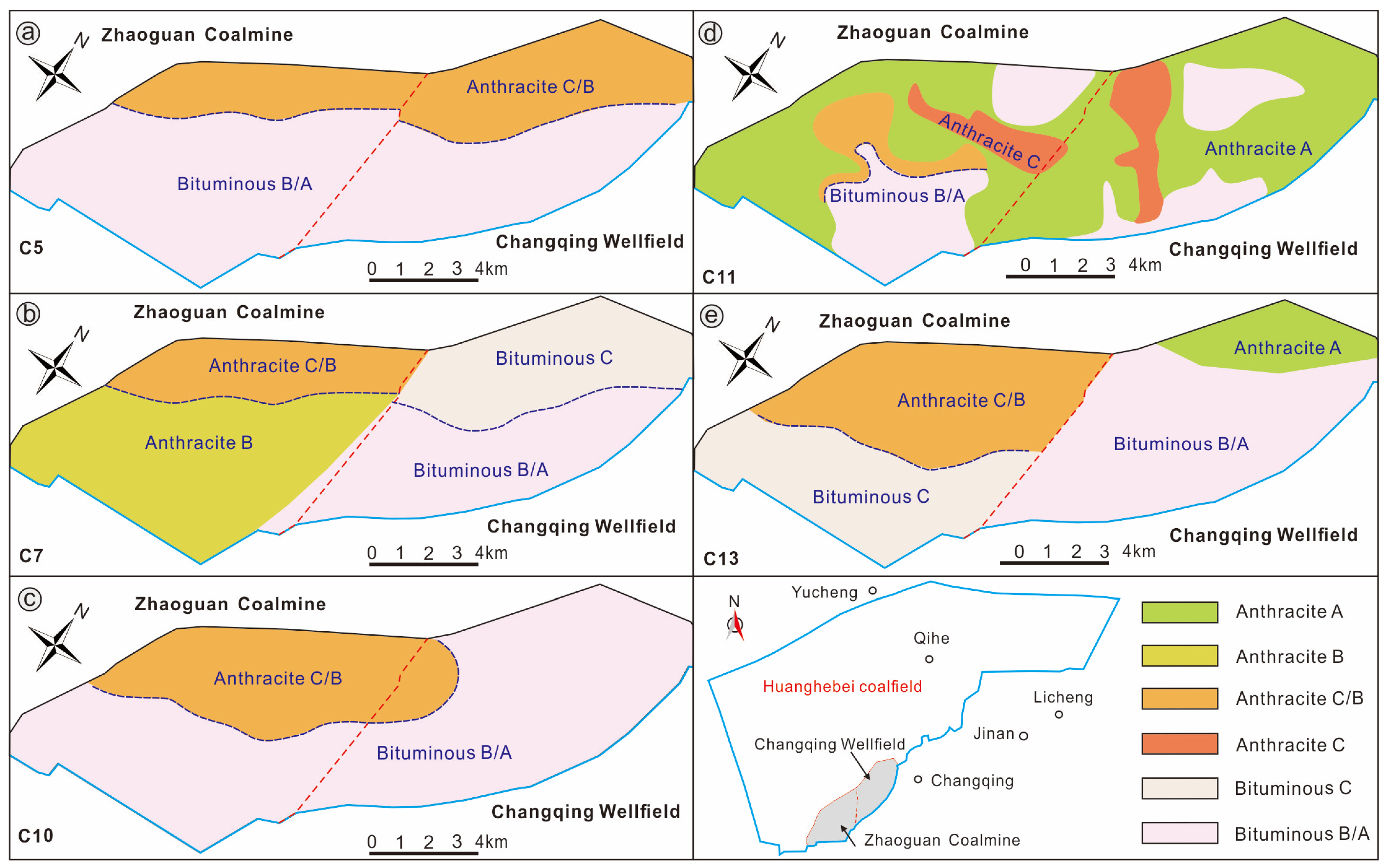


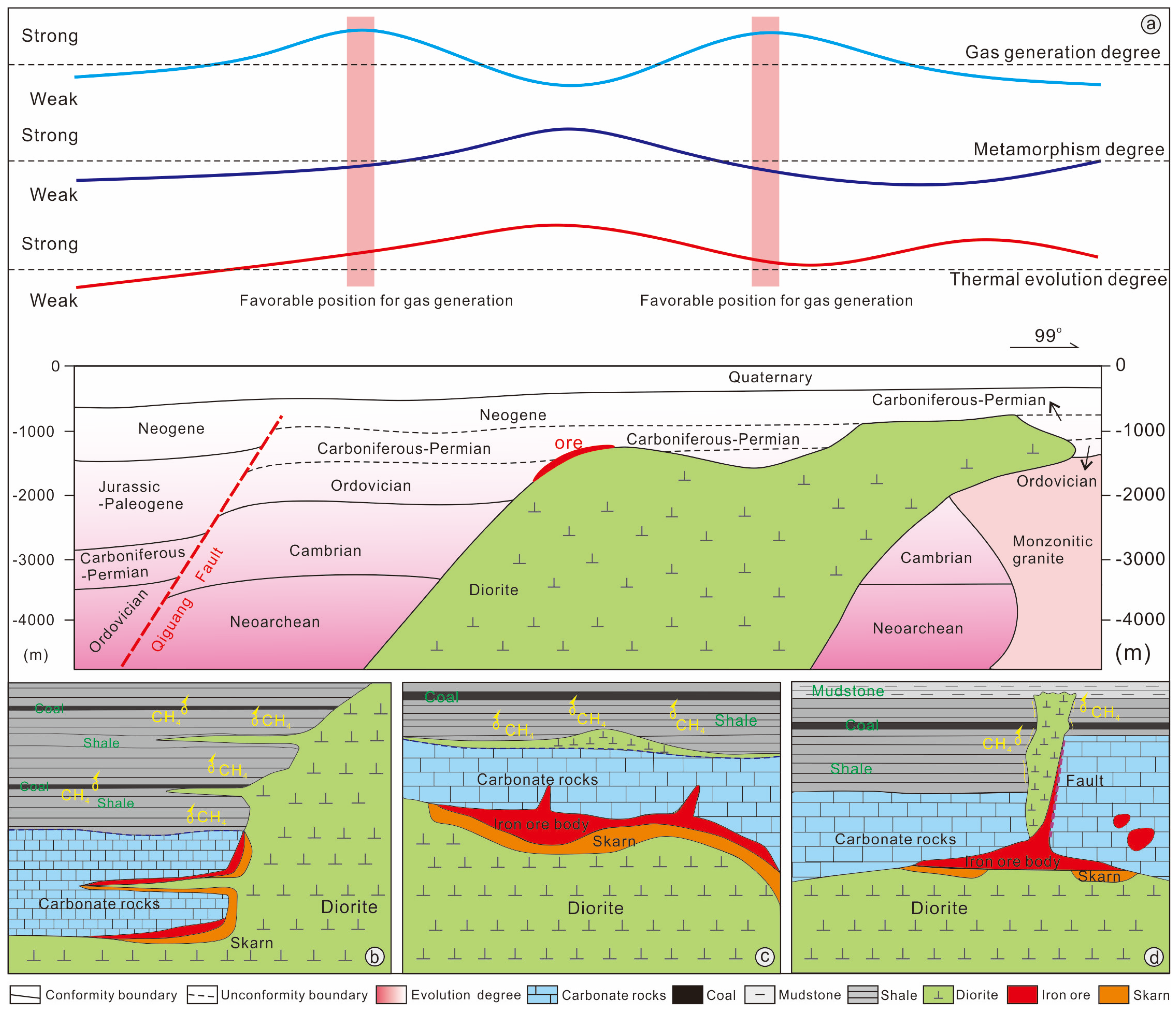
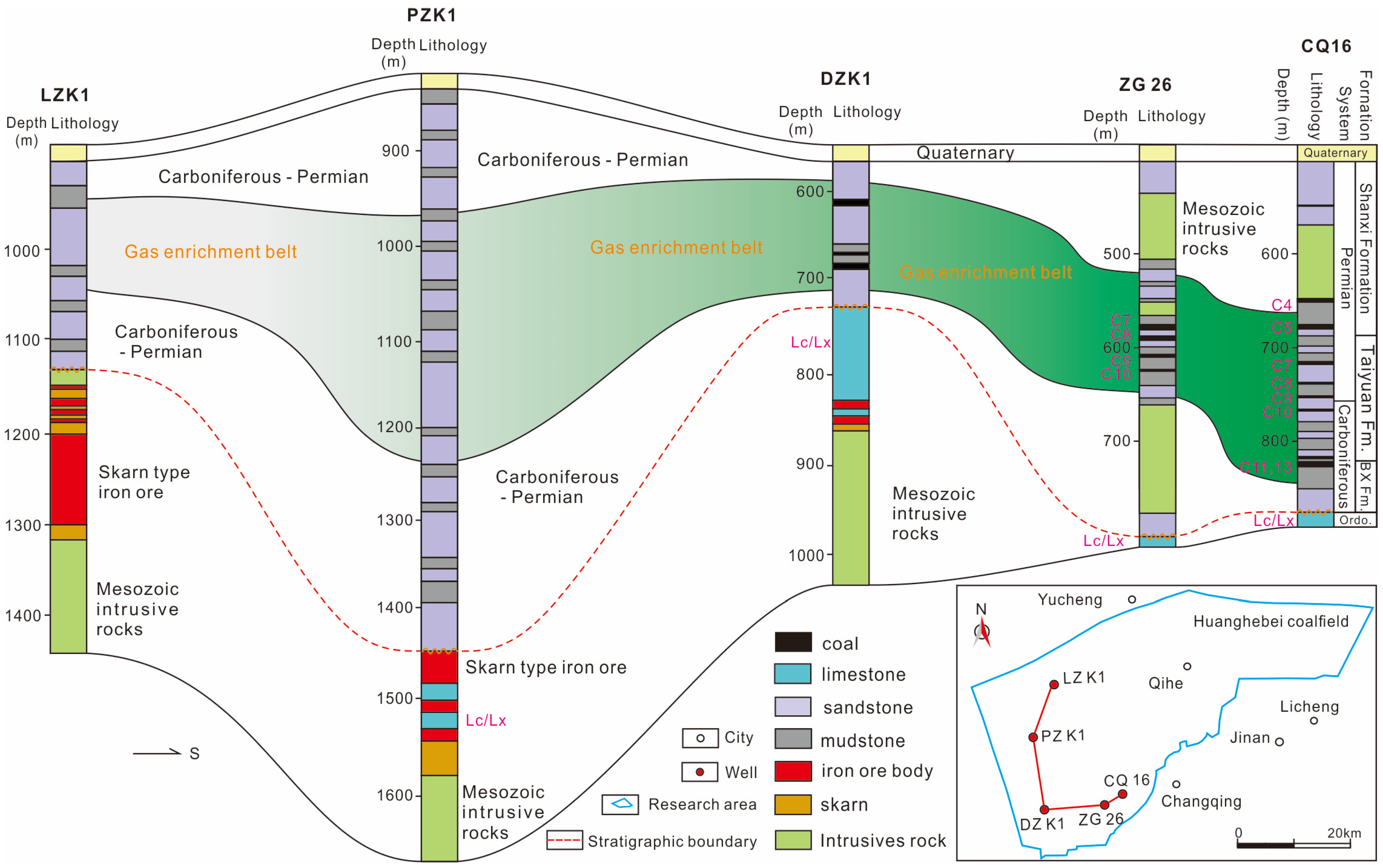
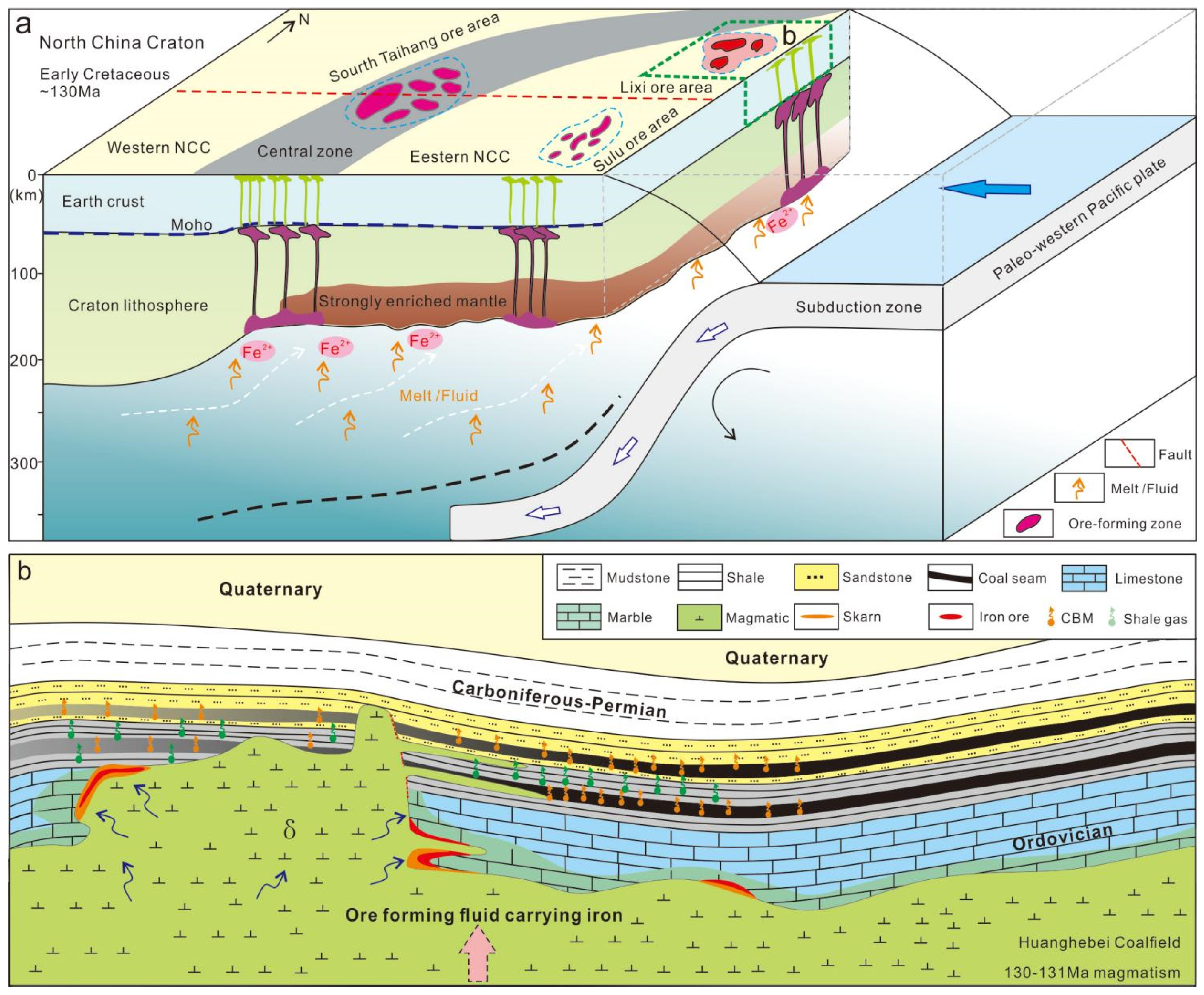
| Changqing Wellfield | C5 | C7 | C10 | C11 | C13 |
|---|---|---|---|---|---|
| Romax, % | 0.79~2.26 | 0.75~0.96 | 0.74~0.97 | 0.72~6.35 | 0.70~2.38 |
| = 1.53 | = 0.82 | = 0.81 | = 3.20 | = 0.92 | |
| coal rank | bituminous C–A, anthracite C | bituminous C | bituminous C | bituminous C–A, anthracite C–A | bituminous C–A, anthracite C |
| metamorphism stage | high maturity stage | maturity stage | maturity stage | over maturity stage | high maturity stage |
| coal thickness (m) | 0~0.90 = 0.69 | 0.34~1.01 | 0.35~1.35 | 0~4.10 | 0.75~3.30 |
| = 0.82 | = 0.80 | = 1.58 | = 1.92 | ||
| gas content (m3/t) | 0.05~15.28 | 0.01~7.31 | 4.51~5.51 | 1.20~5.37 | 0.04~5.44 |
| = 6.32 | = 4.66 | = 5.01 | = 3.28 | = 2.43 |
| Sample. No. | Depth (m) | Tmax (°C) | Maturity | S1 (mg/g) | S2 (mg/g) | S1 + S2 (mg/g) | Source Rock Rank |
|---|---|---|---|---|---|---|---|
| S1 | 526.84 | 471.9 | moderate | 0.05 | 0.73 | 0.78 | poor |
| S2 | 545.03 | 471.9 | moderate | 0.01 | 0.18 | 0.19 | no |
| S3 | 555.32 | 471.9 | moderate | 0.01 | 0.08 | 0.09 | no |
| S4 | 657.2 | 471.9 | moderate | 0.01 | 0.10 | 0.12 | no |
| S5 | 660.51 | 476.4 | moderate | 0.04 | 0.09 | 0.13 | no |
| S6 | 668 | 476.4 | moderate | 0.02 | 0.09 | 0.10 | no |
| S7 | 682.39 | 476.4 | moderate | 0.12 | 0.33 | 0.45 | no |
| S8 | 692.25 | 476.4 | moderate | 0.27 | 0.93 | 1.20 | poor |
| S9 | 699.83 | 476.4 | moderate | 0.25 | 0.84 | 1.09 | poor |
| S10 | 702.07 | 476.4 | moderate | 0.12 | 0.58 | 0.70 | poor |
| S11 | 707.37 | 476.4 | moderate | 2.95 | 14.50 | 17.45 | good |
| S12 | 709.6 | 476.4 | moderate | 0.38 | 1.73 | 2.10 | medium |
| S13 | 711.25 | 476.4 | moderate | 0.76 | 12.53 | 13.29 | good |
| S14 | 721.71 | 476.4 | moderate | 0.08 | 0.67 | 0.75 | poor |
| S15 | 725.53 | 476.4 | moderate | 0.09 | 0.83 | 0.93 | poor |
| S16 | 740.33 | 476.4 | moderate | 0.11 | 1.41 | 1.52 | poor |
| S17 | 742.79 | 476.4 | moderate | 0.09 | 1.11 | 1.20 | poor |
| S18 | 752.22 | 476.4 | moderate | 0.13 | 1.39 | 1.51 | poor |
| S19 | 755.8 | 476.4 | moderate | 0.17 | 1.54 | 1.71 | poor |
| S20 | 757.5 | 476.4 | moderate | 0.08 | 0.24 | 0.32 | no |
| S21 | 766 | 476.4 | moderate | 0.10 | 0.20 | 0.30 | no |
| S22 | 790.94 | 476.4 | moderate | 0.13 | 1.59 | 1.72 | poor |
| S23 | 793.14 | 476.4 | moderate | 0.07 | 0.92 | 0.99 | poor |
| S24 | 798.5 | 476.4 | moderate | 0.10 | 0.60 | 0.70 | poor |
| S25 | 807.88 | 476.4 | moderate | 0.13 | 1.36 | 1.50 | poor |
| S26 | 812.06 | 476.4 | moderate | 0.10 | 0.91 | 1.01 | poor |
| S27 | 821.55 | 476.4 | moderate | 0.35 | 3.88 | 4.23 | medium |
| S28 | 823.55 | 476.4 | moderate | 0.12 | 0.92 | 1.03 | poor |
| S29 | 824 | 476.4 | moderate | 0.16 | 1.20 | 1.36 | poor |
| S30 | 830.55 | 476.4 | moderate | 0.21 | 2.49 | 2.70 | medium |
| S31 | 842.44 | 476.4 | moderate | 0.06 | 0.88 | 0.93 | poor |
| S32 | 851.72 | 476.4 | moderate | 0.07 | 0.70 | 0.77 | poor |
| S33 | 769.96 | 476.4 | moderate | 0.12 | 4.24 | 4.36 | medium |
| S34 | 817.6 | 476.4 | moderate | 0.15 | 0.28 | 0.43 | no |
Disclaimer/Publisher’s Note: The statements, opinions and data contained in all publications are solely those of the individual author(s) and contributor(s) and not of MDPI and/or the editor(s). MDPI and/or the editor(s) disclaim responsibility for any injury to people or property resulting from any ideas, methods, instructions or products referred to in the content. |
© 2024 by the authors. Licensee MDPI, Basel, Switzerland. This article is an open access article distributed under the terms and conditions of the Creative Commons Attribution (CC BY) license (https://creativecommons.org/licenses/by/4.0/).
Share and Cite
Yin, L.; Wang, H.; Wang, D.; Liu, Y.; Liu, H.; Zhu, Y.; Shen, L.; Li, Z. Magmatic Intrusion during the Yanshanian Period and Multi-Mineral Enrichment Mechanisms in the Eastern Margin of the North China Craton. Minerals 2024, 14, 332. https://doi.org/10.3390/min14040332
Yin L, Wang H, Wang D, Liu Y, Liu H, Zhu Y, Shen L, Li Z. Magmatic Intrusion during the Yanshanian Period and Multi-Mineral Enrichment Mechanisms in the Eastern Margin of the North China Craton. Minerals. 2024; 14(4):332. https://doi.org/10.3390/min14040332
Chicago/Turabian StyleYin, Lusheng, Huaihong Wang, Dongdong Wang, Yinan Liu, Haiyan Liu, Yuzhen Zhu, Lijun Shen, and Zengxue Li. 2024. "Magmatic Intrusion during the Yanshanian Period and Multi-Mineral Enrichment Mechanisms in the Eastern Margin of the North China Craton" Minerals 14, no. 4: 332. https://doi.org/10.3390/min14040332





